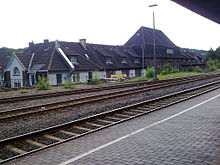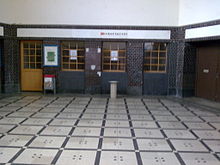Gummersbach-Dieringhausen train station
| Gummersbach-Dieringhausen | |
|---|---|
 Dieringhausen station building
|
|
| Data | |
| Operating point type | railway station |
| Location in the network |
Intermediate station
former separation station (1920–1997) |
| Design | Through station |
| Platform tracks | 2 |
| abbreviation | KDI |
| IBNR | 8000363 |
| Price range | 5 |
| opening | 1887 |
| location | |
| City / municipality | Gummersbach |
| Place / district | Dieringhausen |
| country | North Rhine-Westphalia |
| Country | Germany |
| Coordinates | 50 ° 59 '7 " N , 7 ° 32' 33" E |
| Railway lines | |
| Railway stations in North Rhine-Westphalia | |
The Gummersbach-Dieringhausen train station has existed since 1887 and made the formerly insignificant village of Dieringhausen (district of Gummersbach ) a regionally important place from 1887 to the 1980s, whose former track systems, including the railway depot, as well as the railway settlements shape the townscape.
For a long time the station was an important railway junction in the Oberberg railway network and, although it was not Gummersbach's inner city station, it was the most important station in the district town of Gummersbach.
The Gummersbach-Dieringhausen train station is rated as a historical building . Both reception buildings and the former depot have been under monument protection since 1989. However, the entry for the entire site in the monument list of the city of Gummersbach is still missing in order to preserve all facilities.
Today the station is the terminus for the Siegburg – Olpe and Hagen – Dieringhausen lines and is managed by DB Station & Service in station category 5. In operational terms, it is the most important station along the Aggertalbahn, as trains are refueled in the station and it serves as a storage station at night.
history
The first station was built parallel to Provinzialstraße in 1887 and was later used as a freight station, it is located on the site of the former depot. In 1902 the water tower was replaced by a new building. In 1905/1906 the new locomotive shed with eleven stalls was built. A railroad settlement was also built during the development of the station .
From 1913, the railway systems were moved to a higher level with 14 tracks afterwards. In 1916 the old railway facilities (old station and the locomotive shed in the depot, which was initially only two places ) became a pure depot.
The station, which is still in use today, was not put into operation until 1920.
At times the depot was expanded to include a workshop at the station in Osberghausen , which also served the Dieringhausen station as a train formation station for the Wiehl Valley Railway . The depot was dissolved by the Federal Railroad in 1982 and has housed the Dieringhausen Railway Museum since 1985 .
Until December 8, 2018, the station was called Dieringhausen .

Railway junction
The station was not only the terminus of many railway lines , but also a stop for express trains , for example the express trains from Cologne to Olpe or Hagen , from Wuppertal to Waldbröl or even temporarily from Cologne via Olpe to Paderborn .
The following railway lines came together here:
- the Siegburg – Olpe railway line , in 1979 passenger traffic to Olpe was shut down, and in 1997 all traffic. The turnout of the old branch has been expanded since 2003. For this route, Dieringhausen was not a real locational advantage in terms of passenger traffic, as the connections from Olpe ended in Dieringhausen, and connections, for example, between Bergneustadt and Gummersbach, for example, usually had to be a laborious change here. In addition, trains with direct connections would have had to turn around in the station,
- the Volmetalbahn in the direction of Hagen, on which from the mid-1980s only operated to Gummersbach , which was extended again to Marienheide in 2003 and to Meinerzhagen in early 2014, and again to Bruges from December 2017 .
- the Wiehltalbahn , on which passenger traffic took place until 1965. The route began in Osberghausen , but most trains ended in Dieringhausen or continued to run. Since 1999 the support group for the rescue of the Wiehltalbahn e. V. and the railway museum Dieringhausen Tourismusverkehr on the Wiehltalbahn. Since 2010, the Bergische Löwe has been hauled by the Waldbröl steam locomotive on the Dieringhausen – Wiehl (–Waldbröl) route, every second Sunday of the month from March / April to October; there are also other special trains. The trains start at the Dieringhausen Railway Museum, the station is another option. Since 2005, goods traffic has been carried out again in the form of timber transport trains ; However, this is currently suspended due to a lack of customers.
These routes branched further in the area into the Gummersbacher Kleinbahnen , the Leppetalbahn , the Wissertalbahn and the Wippertalbahn from Marienheide via Wipperfürth to Lennep .
The newer reception building
The style of the large station building of today's train station was based on the Cologne-Deutz train station , according to a historical monument study, the regional importance of the Dieringhausen train station should be emphasized. In the historical monument assessment, this investigation also refers to a study from 2001, which rated the entire site as worthy of monument.
Accidents
In the mid-1930s, a class 74 steam locomotive and a class 57 steam locomotive collided with one another at a switch in Dieringhausen station ( flanking ). Both locomotives derailed.
Status
The former importance of today's regional train station can be seen in the reception building and the very extensive track systems that still exist.
The ticket office in the reception building and the kiosk have been closed for several years, today the building houses a bank and a Chinese restaurant. The former ticket office has been leased again since 2018, and insurance has moved in there.
There used to be two platforms, but no house platform because the tracks are at the roof level of the reception building. The numbering of the platforms was (contrary to the norm) the opposite of the numbering of the tracks, because the northernmost track was track 1, but the northern platform was number 2. The existing staircase to the still-used platform 1 was made barrier-free in 2018 . The further access to the rear platform 2, which has been completely demolished and trackless since 2018, is bricked up. The luggage elevators have long been shut down. The luggage elevator belonging to the platform of platform 1 was replaced by a passenger elevator in 2018. The platform was rebuilt over a total length of 170 meters and raised to a height of 76 centimeters.
Today, at the station Gummersbach-Dieringhausen drive only the to Cologne diesel network Vareo associated regional train 25 RB with railcar type Alstom Coradia LINT 54 or LINT 81 on the two remaining platform tracks as well as the museum trains of Wiehltalbahn (track 2). The train crossing of the RB 25 takes place in Dieringhausen. The other tracks are only partially used as sidings for the LINT railcars (in the eastern area of the station, including the petrol station) and vehicles of the railway museum (in the western area), the other tracks are no longer used, are overgrown and in some cases have already been dismantled.
The former goods handling at the first station at the Railway Museum has not been used since 1997, but the loading tracks are still there. The trucks used to be parked in front of the goods handling area;
future
There are several plans for the reception building to be used for cultural purposes as in Overath.
Railway lines
| line | course | Tact | vehicles |
|---|---|---|---|
| RB 25 |
Oberbergische Bahn : Cologne Hansaring - Cologne Hbf - Cologne Messe / Deutz - Cologne Trimbornstrasse - Cologne Frankfurter Strasse - Rösrath-Stümpen - Rösrath - Hoffnungsthal - Lohmar-Honrath - Overath - Engelskirchen - Ründeroth - Gummersbach-Dieringhausen - Gummersbach - Marienheide - Meinerzhagen - Kierspe - Halver-Oberbrügge - Lüdenscheid-Bruges - Lüdenscheid Status: timetable change December 2019 |
30 min (Cologne – Engelskirchen / Gummersbach) 60 min (Cologne – Lüdenscheid) |
Alstom Coradia LINT 54 and 81 |
|
RB
Bergischer Löwe (museum railway) |
Bergischer Löwe :
Railway Museum Dieringhausen - Gummersbach-Dieringhausen - Osberghausen - Weiershagen - Bielstein - Alperbrück - Wiehl Weiershagen and Alperbrück are demand stops |
individual trains every second and fourth Sunday of the month (March / April – October) + selected public holidays | Waldbröl steam locomotive + 2-3 blunderbusses + baggage car |
Others
The traffic in the Dieringhausen station, on the eastern part of the Aggertalbahn and the connecting lines Biggetalbahn and Asdorftalbahn is simulated in an extension for the Microsoft Train Simulator , which shows the situation in the 1960s / 1970s. At that time, all tracks in the station and depot were still passable, including platform 2.
literature
- Sascha Koch, Horst Kowalski and others: Railways in Oberberg and the history of the Dieringhausen depot. Galunder Verlag, Nümbrecht 2005, ISBN 3-89909-050-0 .
Web links
- Plans for the reception building
- Photos and history
- The former and present condition of the station at Drehscheibe Online
Individual evidence
- ↑ Monument List City of Gummersbach ( Memento from September 10, 2009 in the Internet Archive )
- ↑ Directory of operating locations (status 04/2018) . Deutsche Bahn, May 3, 2018, accessed December 1, 2018
- ↑ http://www.ig-bw-dieringhausen.de/Text_Bahnhof_100104.pdf ( page no longer available , search in web archives ) Use and presentation of a monument - a description of the location
- ↑ bahnen-wuppertal.de
- ↑ rundschau-online.de
- ↑ Preliminary usage and financing concept "KulturBahnhof Dieringhausen" ( Memento from July 14, 2010 in the Internet Archive ) (PDF; 745 KB)





